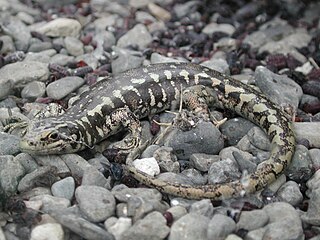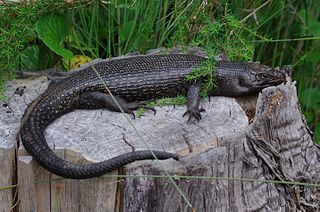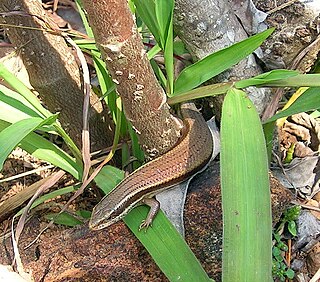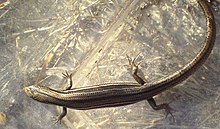Anomalopus is the genus of worm-skinks, smallish smooth-scaled burrowing lizards in the family Scincidae. The genus is endemic to the eastern half of Australia. The genus belongs to a clade in the Sphenomorphus group which contains such genera as Ctenotus and the close relatives Eulamprus and Gnypetoscincus.

Carlia is a genus of skinks, commonly known as four-fingered skinks or rainbow skinks, in the subfamily Eugongylinae. Before being placed in this new subfamily, Carlia was recovered in a clade with the genera Niveoscincus, Lampropholis, and others of the Eugongylus group within Lygosominae.

Cryptoblepharus is a genus of skinks

Egernia is a genus of skinks that occurs in Australia. These skinks are ecologically diverse omnivores that inhabit a wide range of habitats. However, in the loose delimitation the genus is not monophyletic but an evolutionary grade, as has long been suspected due to its lack of characteristic apomorphies.

Eulamprus is a genus of lizards, commonly known as water skinks, in the subfamily Lygosominae of the family Scincidae. The genus is native to Australia.

Chioninia coctei, also called the Cape Verde giant skink, Bibron's skink, lagarto, or Cocteau's skink, was a species of lizard, a reptile that was at one time known to inhabit the islets of Branco and Raso in the Cape Verde islands of the Atlantic Ocean, rendered deserts by human-caused habitat destruction. None have been observed since the early 20th century, and the species was officially declared extinct in 2013.

Carinascincus is a genus of skinks, commonly called snow skinks or cool-skinks and residing mainly in Tasmania or Victoria, Australia. Then recognised as the genus Niveoscincus, it was found to belong to a clade with the genera Carlia, Lampropholis and others of the Eugongylus group within Lygosominae. Cogger has rejected the use of the junior name Niveoscincus and recognizes the valid senior generic name Carinascincus for the group. For similar skinks see genera Pseudemoia, Lampropholis, and Bassiana. These skinks have adapted to the cooler weather of southern Australia and particularly Tasmania, hence the common names.

Oligosoma is a genus of small to medium-sized skinks found only in New Zealand as well as Norfolk and Lord Howe islands. Oligosoma had previously been found to belong to the Eugongylus group of genera in the subfamily Lygosominae; the Australian genus Bassiana appears to be fairly closely related.

The genus Sphenomorphus – vernacularly known as the common skinks – currently serves as a "wastebin taxon" for numerous skinks. While most or all species presently placed here are probably rather close relatives, the genus as presently delimited is likely to be not monophyletic and is in need of review. Some species in this genus have been moved to Pinoyscincus.

Blue-tongued skinks comprise the Australasian genus Tiliqua, which contains some of the largest members of the skink family (Scincidae). They are commonly called blue-tongued lizards or simply blue-tongues or blueys in Australia. As suggested by these common names, a prominent characteristic of the genus is a large blue tongue that can be bared as a bluff-warning to potential enemies. Blue-tongued skinks are also bred in captivity and sold as house pets. They are relatively shy in comparison with other lizards, and also significantly slower due to their short legs.

Eutropis bibronii, also known commonly as Bibron's skink or the seashore skink, is a species of skink, a lizard in the family Scincidae. The species is endemic to India and Sri Lanka.

King's skink is a species of skink, a lizard in the family Scincidae. The species is endemic to Australia.

Trachylepis is a skink genus in the subfamily Lygosominae found mainly in Africa. Its members were formerly included in the "wastebin taxon" Mabuya, and for some time in Euprepis. As defined today, Trachylepis contains the clade of Afro-Malagasy mabuyas. The genus also contains a species from the Brazilian island of Fernando de Noronha, T. atlantica, and may occur in mainland South America with Trachylepis tschudii and Trachylepis maculata, both poorly known and enigmatic. The ancestors of T. atlantica are believed to have rafted across the Atlantic from Africa during the last 9 million years.

Lygosominae is the largest subfamily of skinks in the family Scincidae. The subfamily can be divided into a number of genus groups. If the rarely used taxonomic rank of infrafamily is employed, the genus groups would be designated as such, but such a move would require a formal description according to the ICZN standards.

The eastern three-lined skink, also known as the bold-striped cool-skink, is a species of skink, a lizard in the family Scincidae. The species is endemic to Australia.

Saiphos equalis, commonly known as the yellow-bellied three-toed skink or simply three-toed skink, is a species of burrowing skink found in eastern Australia. It is the only species classified under the genus Saiphos.
Concinnia is a genus of skinks in the subfamily Lygosominae.
The southwestern cool-skink is a species of skink.
Slater's desert skink, also known commonly as the Centralian Floodplains desert-skink, Slater's egernia, and Slater's skink, is a species of lizard in the family Scincidae. The species is endemic to Australia. There are two recognized subspecies.
The red-throated cool-skink or red-throated skink is a species of skink, a lizard in the family Scincidae. The species is endemic to Australia.















